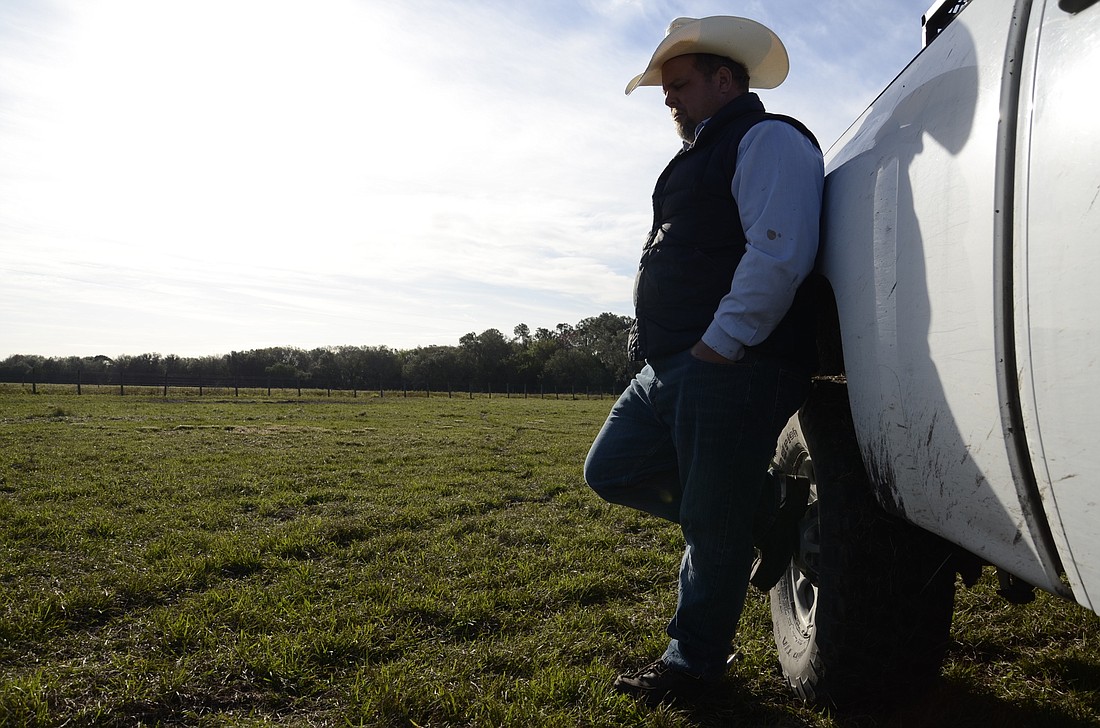- April 4, 2025
-
-
Loading

Loading

Standing in a 20-acre pasture east of Lorraine Road, Jason McKendree remembered the days when he couldn’t hear the sound of bulldozers working on a new subdivision.
That was a time the Mary Fran Carroll Bridge was made of wood and the nearby section of University Parkway was a dirt road where he could easily drive his cattle.
Driving cattle now gets complicated with street lights, stop signs and four-lane roads, but as the manager of cattle operations for Schroeder-Manatee Ranch, the 40-year-old McKendree still has to get it done.
“There’s a lot of aggravation being in the cattle industry in the middle of a master-planned community,” he said. “But that’s just progress. To be a part of this community is pretty cool.”
With a rifle in the front seat of his truck, coffee mug in the console and feed pamphlets covering the dash, McKendree is part of the cowboy culture still found in East County.
“Cattle today are on roller skates,” he said. “They’re here today but might be moved three pastures over tomorrow.”
If he gets notice of a land sale, McKendree has about 30 days to move any cattle off the acreage and to find a new home for them, at least, until that piece is purchased.
McKendree is not the only rancher who has to deal with development constraints.
Steven John, president of the Manatee County Cattlemen’s Association, said it is not easy to get into the cattle industry these days, but it still has a viable presence in Manatee County.
Fewer large-scale cattle ranches exist today and most producers only have 100 head of cattle or fewer. Established ranchers are leaving the industry, and today’s ranches have smaller herds or have partnered with other ranches for management.
“It’s more consolidation than decline,” John said. While some aspects of being a cowboy haven’t changed, the world of cattle has advanced.
Cowboy scientists
Jim Strickland, owner of Strickland Ranch and Exports and manager of Blackbeard Ranch and Big Red Cattle Co., doesn’t have to worry about development near his cattle. The former county cattlemen’s association president and current chairman of
the National Cattle Beef Association political action committee has land near Myakka River State Park and just north of the Manatee River. His total operation is about 1,600 acres.
Over his 60 years of ranching, Strickland said technology is the biggest change. Every steer has a tag in its ear with a barcode that, when scanned, can show all the data that have been recorded on that animal. From vaccinations to previous weigh-ins, Strickland has an electronic file for every one of his steers. He still manually collects data for his heifers, but said in the next couple years he’s hoping to add them into the system, too.
Keeping up with university research, Strickland also uses a program developed by Kansas State University to estimate how much money he can make off of a steer.
He uses UF/IFAS Extension research to stay on top of the latest medications, vaccinations and technology available to him.
Studying genetics has become a major endeavor for ranchers today. Strickland said before, it was more of a visual selection process. Now, genetics can determine everything from fat percentage to the size of a rib-eye steak a cow will produce.
The best technology can’t change everything. Both Strickland, his foreman Mike Tooley, and McKendree still work cattle with dogs and horses.
“At the end of the day, there’s only one way to be a rancher, and that’s old school,” McKendree said.
The future of cattle ranching
McKendree’s land for cattle may be shrinking, but he said he doesn’t get discouraged.
“It’s pretty evident real estate is coming,” he said. “Once it goes to concrete, it never goes back to grass.”
The future of cattle ranching will lie in a rancher’s ability to adapt to smaller spaces, he said. Ranchers have to learn how to operate with similar cattle counts even if their acreage shrinks.
SMR has made some advancements in that way of thinking. McKendree changed over the kind of grass seeded in the pastures so it’s higher-quality foraging.
With the previous bahia grass, every cow needed five acres for grazing. The switch to different grass lowered that ratio to one acre per cow.
Strickland’s vision for the future involves diversification.
He has many plans for the acreage at Blackbeard Ranch besides cattle. He harvests extra palm trees to sell to developers, hosts hunter-jumper courses for riders and is currently working with companies that put on competitive mud races, like Tough Mudder, to host a race on the property. He wants to open a lodge eventually as an ecotourism attraction where people can stay and experience a working ranch.
“My grandpa said, ‘You have your whole life to make money, but make sure you wake up happy in the morning,” Jason McKendree said. “This is where I want to be. If I was offered any other job, I wouldn’t want it.”